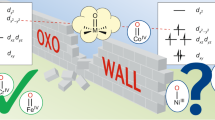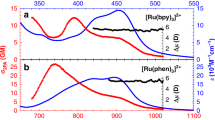Abstract
THE electronic structures of the d1 chromophores VO2+, CrO3+, and MoO3+ have been the subject of much debate1–4, particularly after the early molecular orbital (m.o.) calculations of Gray et al.5,6. An important feature of the electronic spectral assignments suggested5,6 was that the first two absorptions correspond to the d–d transitions dxy→dxz,yz and dxy→ respectively, in the d-orbital sequence dxy (b2) < dxz, dyz(e) < (b1) < dz2(a1). These assignments have found general acceptance and have formed the basis for the interpretation7 of the electron spin resonance (ESR) spectra and bonding parameters of these complexes. We report here experimental results contradicting the assignment of the second absorption.
This is a preview of subscription content, access via your institution
Access options
Subscribe to this journal
Receive 51 print issues and online access
$199.00 per year
only $3.90 per issue
Buy this article
- Purchase on Springer Link
- Instant access to full article PDF
Prices may be subject to local taxes which are calculated during checkout
Similar content being viewed by others
References
Ziebarth, O. V., and Selbin, J., J. inorg. nucl. Chem., 32, 849–865 (1970) and references therein.
Garner, C. D., Hillier, I. H., Mabbs, F. E., and Guest, M. F., Chem. Phys. Lett., 32, 224–226 (1975) and references therein.
Selbin, J., Chem. Rev., 65, 153–175 (1965).
Robbins, D. J., Stillman, M. J., and Thompson, A. J., J. Chem. Soc. Dalton Trans., 813–820 (1974) and references therein.
Ballhausen, C. J., and Gray, H. B., Inorg. Chem., 1, 111–122 (1962).
Hare, C. R., Bernal, I., and Gray, H. B., Inorg. Chem., 1, 831–835 (1962).
Manoharan, P. T., and Rogers, M. T., J. chem. Phys., 49, 5510–5518 (1968) and references therein.
Feltz, A., and Langbein, H., J. inorg. nucl. Chem., 32, 2951–2957 (1970) and references therein.
Ballhausen, C. J., Introduction to Ligand Field Theory, ch. 6 and 8 (McGraw-Hill, New York, 1962).
Author information
Authors and Affiliations
Rights and permissions
About this article
Cite this article
GARNER, C., HILLIER, I., KENDRICK, J. et al. The electronic structure of VO2+, CrO3+, and MoO3+ complexes. Nature 258, 138–139 (1975). https://doi.org/10.1038/258138a0
Received:
Accepted:
Issue Date:
DOI: https://doi.org/10.1038/258138a0
This article is cited by
-
On the existence of VXn+ (X = O,S,Se; n = 0,1,2) Ions and their tetrachloro complexes: Semi-empirical molecular orbital calculations
Transition Metal Chemistry (1978)
-
The chemistry of chromium(V) oxide trichloride
Transition Metal Chemistry (1978)
Comments
By submitting a comment you agree to abide by our Terms and Community Guidelines. If you find something abusive or that does not comply with our terms or guidelines please flag it as inappropriate.



